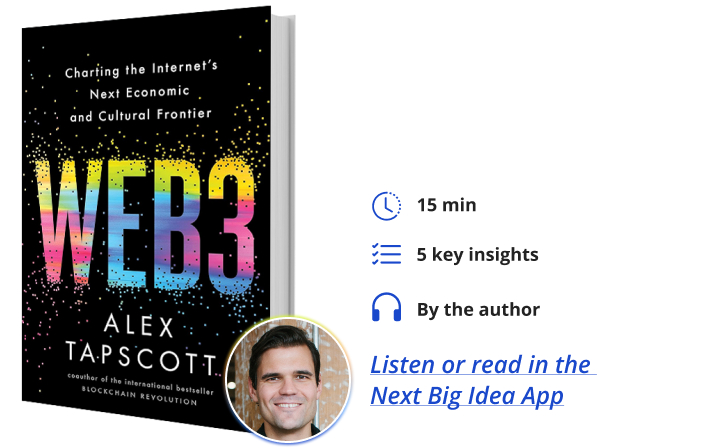Alex Tapscott is a writer, technology investor, and co-founder of The Blockchain Research Institute. He is also the Managing Director of the Digital Assets Group at Ninepoint Partners, one of Canada’s leading investment firms. His writing has been featured in the New York Times, Harvard Business Review, TIME, and Fortune, among other publications.
Below, Alex shares five key insights from his new book, Web3: Charting the Internet’s Next Economic Frontier. Listen to the audio version—read by Alex himself—in the Next Big Idea App.

1. We are entering a new era known as Web3.
Over the past three decades, we’ve moved from the “Read-only Web,” which offered little more than static content, to the “Read-Write Web,” which turned internet users into content creators and opened new ways to collaborate online.
While this new Web, known as Web2, revolutionized media, retail, and other industries, the profusion of data hacks and online profiling have led many to view digital life as a Faustian bargain in need of a major rethink. What’s worse, in Web2 intermediaries and tech giants became gatekeepers, enacting barriers and imposing tolls on everything, stifling innovation and economic freedom online.
Enter Web3, the “Read-Write-Own Web”—a decentralized Internet where individuals own their identities and online creations, and can securely trade assets like money, securities, intellectual property, art, and data peer-to-peer.
“Web3 is the Internet’s next economic and cultural frontier.”
Web3 turns internet users into internet owners. Web3 enshrines digital property rights where none existed before. Web3 empowers individuals at the expense of platforms. Web3 allows us to reimagine cultural industries, transform money and markets, usher in new kinds of assets and organizations, and support greater global participation in our digital economy. Web3 is the Internet’s next economic and cultural frontier.
Some frontiers are for experts only and require vast amounts of capital or superhuman strength, like climbing Mount Everest or journeying to Mars. But the most bountiful of frontiers in history have often been pushed by everyday people, or at least the ones brave enough or driven by circumstances to pack up their belongings and hit the trail. Frontiers attract brilliant businesspeople, outcasts, criminals, and homesteaders. All frontiers present their share of risk and rewards. However, unlike the frontiers of old, the web’s next economic and cultural frontier is boundless and infinite. We should push it forward.
2. The next Silicon Valley won’t be a place.
Silicon Valley was once called a tech Galápagos for the unique blend of talent, money, technology, culture, and government research and development that led to the diverse species of tech entrepreneurs who founded today’s mammoth Internet companies. (The World Wide Web was invented by English computer scientist Sir Tim Berners-Lee in Switzerland, but it was commercialized in the United States.)
This time is different. Web3 is emerging at a time when technology tools and human capital are more distributed than ever. In 1993, as the Web’s pioneers were forging the first frontier online, half the world had never placed a phone call. Now more than two out of every three people on Earth has a smartphone connected to the Internet. To build on science fiction author William Gibson, the future is already here, and its talent and technology are almost equally distributed. If Web1 and Web2 democratized access to information and made it easier to meet and collaborate online, Web3 equips us with a more powerful toolset to earn money, own assets, and build wealth on a globally level playing field, decentralizing power and influence in the process. If the spread of technology truly makes the world “flatter,” then Web3 will be a steamroller. How will America compete when the world is truly flat? What other countries will win in Web3? What can individuals do to stay ahead?
3. The digitization of assets will reimagine financial services.
Web3 is ushering in the greatest transformation to financial services since the invention of double-entry book-keeping in the Middle Ages. Some banks will survive but will be unrecognizable. Most financial innovation (fintech) has been nothing more than digital wallpaper on the old edifice of banks and other powerful institutions. DeFi, short for decentralized finance, reimagines finance from first principles, such as lending, payments, and more. DeFi is a new foundation for the digital economy and digital assets are the tools we’ll use to build it. Already, DeFi has attracted more than $50 billion and millions of users.
“Tokens are to Web3 what websites were to Web1.”
When it comes to digital assets, or “tokens,” myths and misinformation abound. Often, all tokens are classified as “cryptocurrencies.” This is unfortunate, as the term cryptocurrency is a misnomer. Most tokens are not trying to be currencies in the classical sense of a medium of exchange, value for unit. Rather, tokens enabled by Web3 are containers for value that can be infinitely programmed to represent anything of value, just as a website is a tabula rasa for programming information online.
So, tokens are to Web3 what websites were to Web1. This is not about any single token, but rather 11 different types of digital assets already making an impact in art, civil society, finance, government, and more. My book unveils the updated token taxonomy of digital assets that are impacting every industry and institution in the economy.
4. Culture needs a new business model.
Culture needs a new business model. But this time technology can be part of the solution. Web3 enables creators to get paid fairly and promptly and to continue to earn a fair share from their work. Consider the story of the Agregado family who lives in Manilla. Like so many families, their youngest son, Sevi, was born with autism. As in so many countries, they received no government assistance to help their son thrive.
They enrolled Sevi at an early age in programs like art therapy, gymnastics, and football. For five hours a day, he developed skills and learned how to handle social interactions. Eventually, the costs became too great. The Agregados invited eight-year-old Sevi to decide which program he wanted to continue. He chose art.
Sevi’s mom April told me how Sevi’s paintings speak for him when words don’t come easily. Ever the proud parent, April started posting pictures of his pieces to Facebook, where they caught the eyes of friends and family. A few people asked to buy them. April was reluctant—Sevi preferred to give his art to his three sisters. Then, in March 2021, a friend told April about NFTs, or non-fungible tokens. The Philippines was emerging as a hotbed of Web3 innovation.
With the help of her friend, April learned to mint an NFT—that is, to create a unique digital version of each of Sevi’s pieces. April listed a few of them on the NFT marketplace OpenSea, along with some information about Sevi.
“While Sevi’s story as an artist may not be replicable, the tools he used are available to everyone.”
Sevi’s story struck a chord and he recorded his first sales. He was also invited to showcase his work at the industry’s biggest event, NFT.NYC, where his art was displayed on a Times Square billboard. Sevi has earned about $16,000 from sales of his art. That’s more than the average Filipino makes in a year. While Sevi’s story as an artist may not be replicable, the tools he used are available to everyone. They give individuals ownership over their digital goods. Thanks to his NFTs, April can now afford to give Sevi the help he needs.
5. When it comes to technology investing, history doesn’t repeat, but it often rhymes.
Every few decades, a new technology emerges that rewires the economic power grid. We saw it most recently with the internet. Before that, it was the transistor, the radio, electricity, the steam engine, and the printing press. Today, several revolutionary technologies are emerging all at once: artificial intelligence, the Internet of Things, biotechnology, virtual and augmented reality, robotics, and blockchain. Though each of these technologies can sometimes feel like an overnight success story, they are in fact decades in the making.
This is to be expected. Technology is cyclical and every industry has setbacks. Did the age of exploration end with the first failed voyage? Did the joint stock company fade from memory after the collapse of the South Sea Bubble? Was the Industrial Revolution over with the Panic of 1873, which led to the collapse of a few banks and railroads? Did we call it quits on the web in 2001? Or in each case were we at the beginning, not the end, of an era of staggering change, upheaval, and progress?
In the mid 90’s there were many highly valued stocks, like Borders, Kodak, Tower Records, Blockbuster, Polaroid, Compaq, Dell, Nortel, Nokia, Xerox, JC Penny, Sears, Palm, Sony Walkman, and America Online, who failed to embrace the first eras of the Web. If viewed through the lens of the Internet, investors would have valued them differently. Web3 provides a new lens to help investors understand which traditional companies and innovators are best and poorest equipped to transform themselves for a new paradigm.
As with prior eras of the Internet, Web3 will become an integral technology for business. The companies that harness this technology will not just survive but thrive in this next era of digital disruption.
To listen to the audio version read by author Alex Tapscott, download the Next Big Idea App today:































